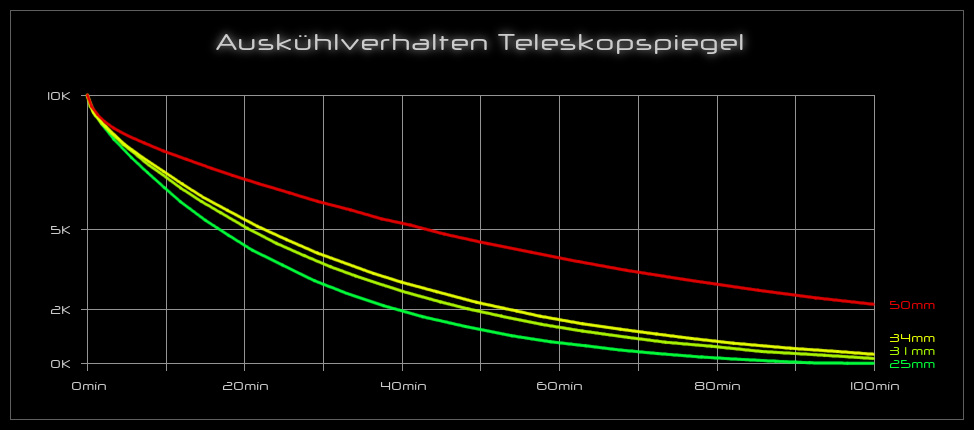
Lightweight Dobson Telescopes And High Quality Parabolic Mirrors - Made in Germany!
For a few months only: reduced prices for the Infinity NL model series
Mirror Cooling
1) Cooling behaviour of telescope mirrors
At the beginning of each expedition into the universe, when the telescope is taken out of the home or after a long drive transitions from the warm car to the cold
outside, the mirror temperature is mostly considerably higher than the ambient temperature. Especially during the winter this difference can easily be 20 degrees
Kelvin (K) or more.
The higher the temperature gradient between mirror and environment, the longer one has to wait until the telescope can be used for observing. The reason for this
is that due to this temperature difference the mirror creates a bubble of warm air directly above its surface. This bubble does not have the same index of refraction
as the surrounding air. The starlight collected by the primary mirror has to pass through this bubble. The bubble is not a static shap, it erratically changes its shape
with the wind and air turbulences all the time, continuously deforming and distorting the wavefront of the light. When using the telescope this process manifests as
very turbulent, wobbling images and seemingly inflated stars.
Only once the mirror has almost reached ambient temperature the images get more steady and become sharp, the telescope can finally tap into its full performance.
Unfortunately this phenomenon does not only occur at the beginning of the night. Usually the ambient temperature continues to drop during the night until the early
morning. The mirror therefore has to continously adapt its temperature to keep up with the environment. If this adaptation process is to slow, the unwanted warm air
bubble above the returns and the images get blurry again.
The described effect of the air bubble above the primary distorting the imaging quality of a telescope is called „Telescope-“ or „Mirror-Seeing“ and is not related to
the atmospherical seeing term, however it is just as detrimental to the joy of observing the universe.
2) Advantages of a thin mirror
It is rather obvious that when looking at the same size concerning diameter a very thin mirror will adapt to the ambient temperature considerably faster than a
significantly thicker mirror of the same size. The usage of high magnifications is mostly only possible when the temperature difference between mirror and
environment is below 2 degrees Kelvin (2K).
The presented diagram which was simulated using the „Mirror Cooling Calculator“ illustrates the cooling behaviour of two mirrors with the same diameter (16“)
that are differing in thickness (25mm vs. 45mm). The diagram shows the cooling process at the beginning of the night. Both mirrors start with a temperature
difference of 10K compared to the ambient temperature. To simplify the example, further temperature changes during the night were not simulated, instead a
constant temperature was assumed.

From the diagram it is clear that the thin mirror with an edge thickness of 25mm made „Borofloat 33“ permits the usage of high magnification after around 40min.
In contrast to that the thick mirror with an edge thickness of 45mm made of „BK7“ reaches this point only after 95min needing more than double the time compared
to its thin counterpart.
When directly comparing these two mirrors one gains almost an hour of quality observing time when choosing the thin mirror. This is exactly the reason why all
mirrors manufactured by Spacewalk Telescopes are exceptionally thin – 25mm for all mirrors up to a diameter of 455mm, 31mm for mirror sizes between 455mm
and 550mm and 34mm for the 635mm size. This significantly increases the difficulty in manufacturing the mirrors but the additional effort is more than worth it.
Under real-life conditions the described phenomenon has even more impact since the air will cool down further during the night and not remain at a constant value
as assumed in the simplified example. This is especially the case for the early hours of the evening. So the difference between mirror- an ambient temperature will
not come down as quickly in real life. While a thin mirror will handle this additional challenge quite easily, a very thick mirror will have even more problems with
keeping up.